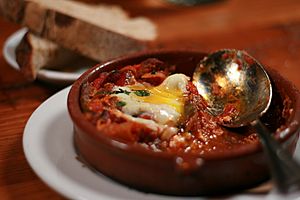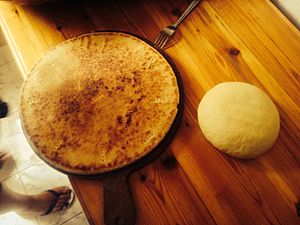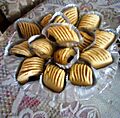Algerian cuisine facts for kids
Quick facts for kids Cuisine of Algeria |
|
|---|---|
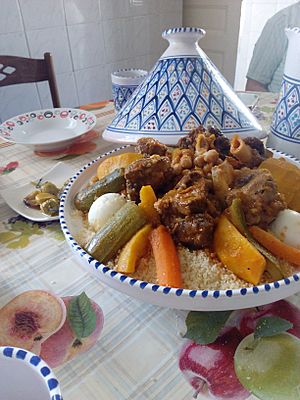
Couscous, often considered the national dish of Algeria
|
|
| Standard Arabic | |
| Abjad | المطبخ الجزائري |
| Romanization | Al-Maṭbakh al-Jazā’irī |
| Algerian Arabic | |
| Abjad | الكوزينة تاع دزاير |
| Latin | El Couzina ta3 Dzaïr |
| Tamazight | |
| Tifinagh | ⵜⴰⴽⵓⵣⵉⵏⵜ ⵏ ⴷⵣⴰⵢⴻⵔ |
| Latin | Takuzint n Dzayer |
| Abjad | ثاكوزينت ن زّاير |
| French | |
| French | Cuisine algérienne |
| IPA | [kɥizin alʒeʁjɛn] |
The cuisine of Algeria is a mix of flavors from many cultures. Over centuries, Algeria has traded ideas and foods with other nations. This has created a rich variety of dishes. The food uses many ingredients from both the land and the sea.
Algerian food has roots in Berber traditions. It is also a type of Mediterranean cuisine and North African cuisine. Different regions of Algeria have their own special dishes. But most Algerian meals use vegetables and grains. Common ingredients include bread, meats like lamb or chicken, olive oil, fresh vegetables, and herbs. Vegetables are used in salads, soups, stews, and with couscous. The most famous Algerian dish is couscous, which is seen as the country's national dish.
Contents
Ingredients in Algerian Cooking
Algeria grows many fruits and vegetables. These include Mediterranean types and some tropical ones. Lamb is a very popular meat. People also eat seafood and fish caught along the coast.
Algerian cooking uses many spices. Some common ones are caraway, cumin, cinnamon, turmeric, ginger, and paprika. A special spice mix called ras el hanout can have up to 27 different spices!
Meats Used in Algerian Dishes
Algerians eat a lot of meat. You can find meat in almost every dish. Poultry (like chicken) and beef are also common. Sometimes, people eat game meats like birds or venison as a special treat. In the southern parts of Algeria, people also eat camel meat.
Popular Vegetables
Many vegetables are used in Algerian cooking. These include potatoes, carrots, turnips, onions, and tomatoes. Other common vegetables are zucchini, garlic, cabbages, and eggplant. Olives and chickpeas are also important.
Vegetables are often cooked in stews called tagine or jwaz. They are also used in soups like chorba or harira. Sometimes, vegetables are simply fried or boiled.
Delicious Algerian Dishes

Couscous is a very common and favorite dish in Algeria. Other popular dishes include rechta, shakshouka, karantita, chakhchoukha, and zviti. There are many types of tajines, like tajine zitoune. Merguez is a popular Algerian sausage that came from the Berber people.
Algeria has four well-known traditional soups. These are chorba frik, harira, djari, and tchicha. These soups are usually served at the start of a meal. They are often made with lamb or chicken, chickpeas, tomatoes, and various spices. These soups are especially popular during the holy month of Ramadan.
Algerian salads come in many forms. Some are made with raw vegetables, while others use cooked ones. They can be served hot or cold. Hot salads include zaalouka, which is made with eggplant and tomato. Another hot salad is egg chakchouka, a mix of tomatoes, smoked green peppers, garlic, eggs, and spices.
Algerian chefs are proud of their cooking skills. They use special spices to create unique flavors. Many dishes are cooked in a tajine, which is a special earthenware pot.
More Algerian Dishes
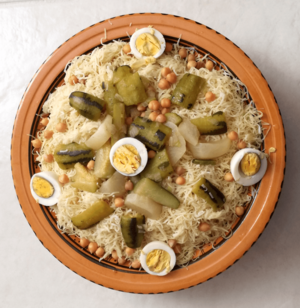
- Bourek – These are fried spring rolls. They can be filled with meat, tuna, potato, or cheese.
- Mhadjeb – A flatbread filled with onions and tomato sauce.
- Shakshouka – A mix of onions, tomato, bell peppers, zucchini, and eggs. There are many versions depending on the region.
- Chorba frik or jari – A tomato-based soup with lamb.
- Frites-omelette – French fries served with eggs.
- Dolma – Vegetables stuffed with fillings and cooked in a broth.
- Tagine or Jwaz – A stew with vegetables (like potatoes, carrots, onions, or tomatoes) and meat. Tajine zitoun (olive tajine) is very popular.
- Tajine hlew – A sweet and savory dish with meat, dried apricots, and prunes.
- Lobia – A thick bean stew often eaten in winter. It can include lentils or kidney beans.
- Chtit'ha – A dish with poultry, onions, and eggs in a red tomato sauce. It's often served at weddings.
- Hmiss – A roasted salad made with bell pepper, tomatoes, garlic, and olive oil.
Desserts and Drinks
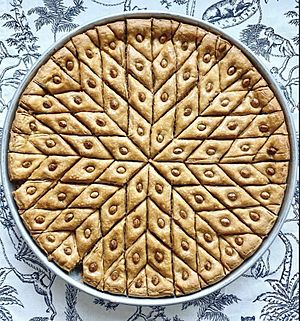
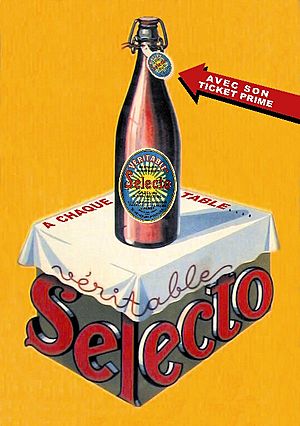
Fresh seasonal fruits are usually served as dessert after meals.
Algerian pastries are very popular. Some examples are dziriyat, garn ghzal, baqlawa, bradj, makroudh, kalb elouz, zlabiya, and griwech. Griwech is a deep-fried, pretzel-shaped dough. It is soaked in honey and sprinkled with sesame seeds. People often eat it during Ramadan. Many pastries are made for special events like Eid-al-fitr and weddings.
Creponne is a type of sorbet that started in Oran. It is a special dessert in Algeria. Other sweets like Sfenj, Kroki, and Mchawcha are also commonly eaten.
Green tea with mint is often drunk in the afternoon. It is also served during ceremonies with pastries. Algerians love coffee. Strong espresso and black coffee are very popular. An Algerian breakfast often includes a latte coffee with croissants or bread. People might also have Algerian sweets like baklawa, msemen, or baghrir with honey or jam.
Fruit juice and soft drinks, called gazouz, are common. The most famous Algerian soda is from Hamoud Boualem. This company started in 1878 and makes popular drinks like "Selecto" and "Hamoud."
Mazagran is a cold, sweetened coffee drink. It is believed to have started in Algeria.
Algeria used to make a lot of Algerian wine. This was during the time of French colonization. Wine production has decreased since Algeria became independent.
Bread in Algeria
Bread is very important in Algeria. It is seen as a symbol of life and good fortune. It is also used in traditions that represent life and plenty.
Types of Algerian Breads
- Khubz as-dâr – This bread is made from wheat flour, water, salt, and yeast. It is usually flat and round. It is made at home and baked in a gas oven.
- Khubz at-tajîn or matlû – This is a flat pan-bread made from wheat semolina. It is baked on a hot earthenware or cast-iron plate over a fire.
- Khubz-ftir, raqâq, rfîs, or tarîd – This is a thin, unleavened dough. It is baked quickly on a curved metal sheet over a fire. This method is good for people who travel a lot because it's easy to carry the pan.
- French baguettes – These are white, leavened wheat flour breads. People usually buy them from bakeries.
Algerian vs. French Breads
Some people used to think French bread tasted better. However, Algerian breads are seen as more nutritious and flavorful. They are also less likely to be wasted. French breads can get hard quickly, but Algerian breads can be reheated or used in other ways.
Homemade Algerian bread is often offered to guests. This shows the family's warmth and hospitality. Having extra bread on the table can also show that a family is doing well financially.
Common Algerian breads include Kesra, Matlouh, Mtabga, and Mouna.
Images for kids
See also
 In Spanish: Gastronomía de Argelia para niños
In Spanish: Gastronomía de Argelia para niños



